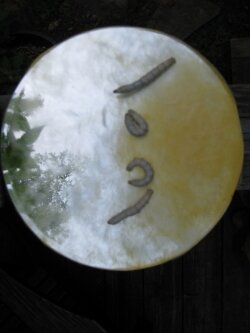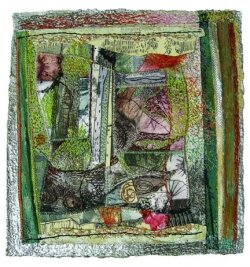Spin doctors: Artists thread the line
In a recent Huffington Post article, biologist Marlene Zuk writes most people are more fearful of insects than of death. I don’t mind bugs; it’s grubs and maggots that give me the heebie-jeebies. If you’re similarly squeamish, steel yourself for Chroma Projects’ current exhibit, “Fecundity,” which showcases colorful oil-pastel and mixed-media abstracts by Janet Grahame Nault (fine) and three metamorphic installations by Elsabe Dixon featuring, yes, living silkworms (yikes).
South African-born Dixon has been working with the pale, several-inches-long worms in her art for over 13 years. She times her installations precisely, hatching her crawling media four weeks in advance and feeding them mulberry leaves daily to prepare them for three days and nights of spinning in the gallery before they metamorphose into moths.
Dixon demonstrates the silkworm lifecycle in her piece, “Living Pod,” installed in Chroma’s front window. Above a glass vase containing a mulberry sapling surrounded by hundreds of cocoons, a multi-celled frame made of mulberry wood dangles from the ceiling. Some of the frame’s compartments contain small mirrors. Others hold cocoons spun on-site. A flightless male and female moth pair perch near rice-like eggs laid in similar cells resting on a circular mirror on top of the vase. During the course of the exhibition, moths will hatch from the frame’s cocoons and remain in the window.
Dixon's work may sound like a science project, but it is nevertheless aesthetically rich. “Living Sculpture, Silk Installation #3” features numerous cloud-like ovals of spun silk on mirror-topped spindles surrounding a sinuous line of nine larger mirrors, each with one or two worms spinning on its surface. Three circular discs of mixed yellow and white silk hang over the arrangement, yielding the overall impression of a galaxy in the midst of gossamer clouds, where small aliens are at work on their individual planets.
In Chroma Projects’ Black Box gallery, hundreds more worms are busy spinning threads across the surface of a garishly fluorescent painting. Dixon’s worm-fueled pieces are so (gross and) engrossing that Janet Grahame Nault’s work risks being overshadowed. But the two artists complement each other, with Grahame Nault’s gestural stitching and seemingly spontaneous scratch-like marks echoing Dixon’s worm-made threads. Although several of Graham Nault’s smaller works shine, her piece de resistance is “Open Door,” a large yet pared-down, geometric symphony of layered colors and textures.
In Dixon and Grahame Nault’s complexly built-up works, one thread leads to the next—whether worm-spun, stitched, or scrawled.

